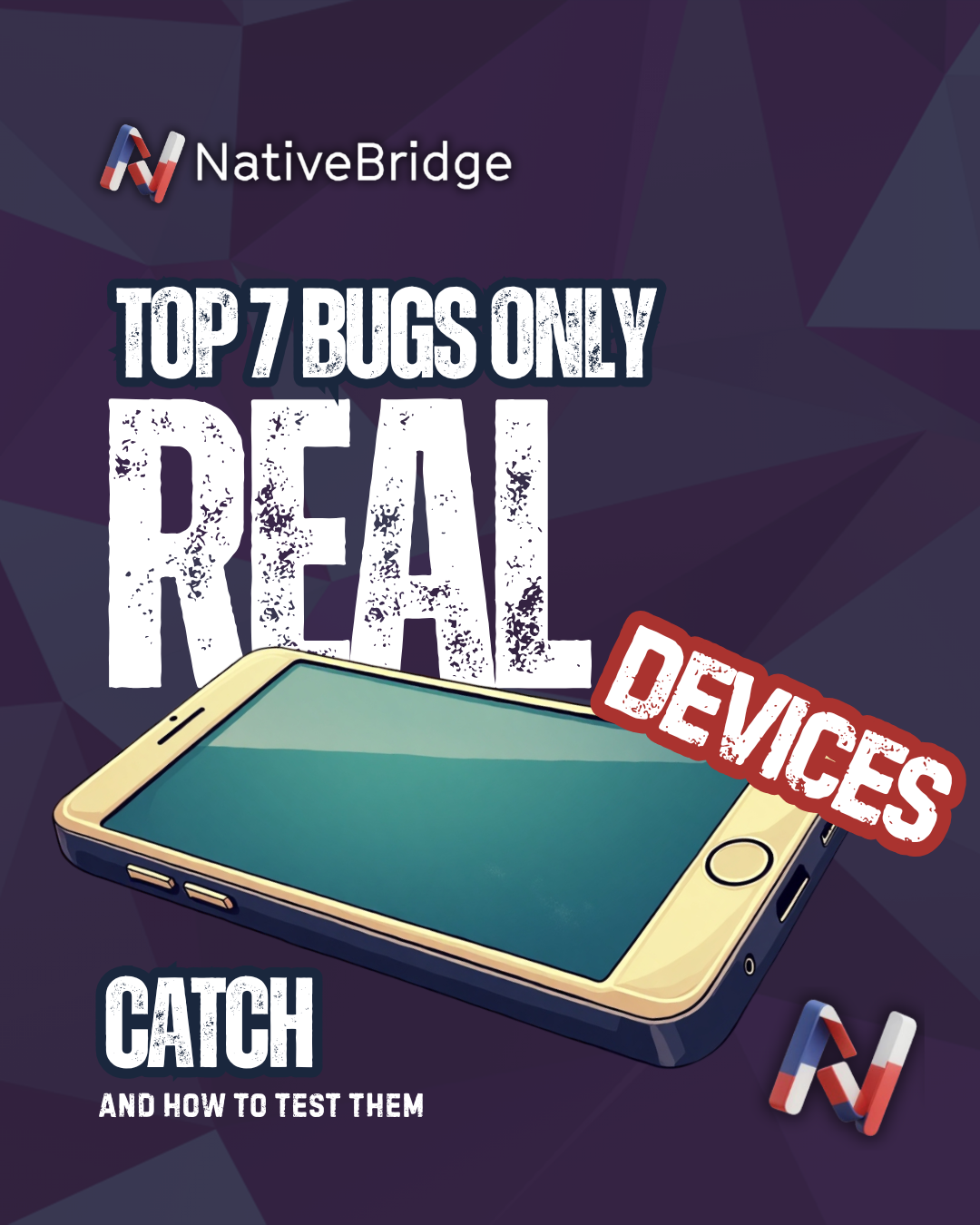Top 7 Bugs Only Real Devices Catch (And How to Test for Them)

Introduction
With the explosive growth of mobile applications across platforms, ensuring a seamless, bug-free experience is no longer optional; it's critical. While emulators and simulators offer quick access and testing flexibility, they fall short when it comes to replicating real-world conditions. Real devices, on the other hand, expose a range of bugs that could severely affect user experience and app performance. In this blog, we dive deep into seven of the most common bugs only real devices catch and explain how to effectively identify and resolve them. We'll also explore how platforms like NativeBridge.io empower developers to solve these problems at scale.
1. Display and Layout Issues on Diverse Screens
The Bug: UI elements break, overlap, or disappear completely on certain devices. This issue becomes especially pronounced with devices having uncommon resolutions, aspect ratios, or notches.
Why Emulators Miss It: Emulators often provide a limited selection of screen resolutions and can't replicate every hardware nuance, such as touch sensitivity or real-time pixel rendering.
How to Test: Use a wide range of physical devices to validate UI consistency. Check for responsiveness across different screen sizes, zoom settings, and font scales.
NativeBridge Use Case: NativeBridge.io's real device cloud enables developers to test on hundreds of devices instantly. This includes the latest Android and iOS smartphones, tablets, and various screen configurations. Developers can quickly uncover and fix layout inconsistencies without maintaining an expensive device lab in-house.
2. Unresponsive or Crashing Buttons
The Bug: A button may not respond to touch input, or tapping it could cause the app to crash.
Why Emulators Miss It: Emulators simulate touch events with a mouse or keyboard input, which doesn't match the sensitivity or pressure variance of physical touches on different devices.
How to Test: Conduct manual touch tests on real devices and use logging tools to trace interaction failures.
Pro Tip: Look out for race conditions in touch event handling and differences in OS versions' gesture recognizers.
3. Battery Drain Issues
The Bug: Your app drains the battery excessively during normal usage, even in background mode.
Why Emulators Miss It: Emulators don’t simulate battery behavior, temperature changes, or energy consumption in real-time.
How to Test: Monitor battery usage statistics via device settings and use profiling tools like Android Profiler or Instruments in Xcode during prolonged app usage on real hardware.
Solution: Optimize background processes, location services, and animations. Implement sleep and pause mechanisms where possible.
4. Interrupt Handling Failures
The Bug: Incoming calls, texts, or notifications crash or freeze the app, or worse, lead to data loss.
Why Emulators Miss It: Most emulators don’t generate real-world interruptions or simulate the system-level behavior associated with them.
How to Test: Physically interact with the app on a real device while intentionally triggering interruptions. Observe app behavior during phone calls, alarm triggers, or while switching apps.
Testing Tip: Always test save-state mechanisms to avoid user data loss when interruptions occur.
5. Audio/Video Playback Issues
The Bug: Media content may lag, stutter, or fail to play entirely due to hardware-specific encoding/decoding issues.
Why Emulators Miss It: Audio and video playback features in emulators are basic and lack real hardware acceleration support.
How to Test: Play media files across different real devices, paying attention to loading times, buffering, and compatibility.
Resolution: Use adaptive bitrate streaming and fallbacks for incompatible codecs.
6. Permission Handling Errors
The Bug: The app crashes or fails to function properly when users deny permissions, or it requests unnecessary access.
Why Emulators Miss It: Many emulators operate with root permissions or bypass permission prompts entirely.
How to Test: Use real devices with freshly installed OS versions and manually test all permission request flows.
Best Practice: Implement graceful fallbacks and user education prompts when permissions are denied.
7. Push Notification Failures
The Bug: Notifications aren’t delivered or displayed properly, affecting engagement and alerts.
Why Emulators Miss It: Push notification services like Firebase Cloud Messaging or Apple Push Notification Service often don’t work properly in emulated environments.
How to Test: Validate push notifications on real devices under varied network conditions. Use logging tools to monitor payload reception and rendering behavior.
Troubleshooting: Check for proper token registration, expired certificates, and platform-specific payload structures.
Conclusion
While emulators remain useful for early-stage debugging and unit testing, they simply can’t replace real devices when it comes to critical aspects like UI accuracy, performance, and user experience. NativeBridge.io offers developers a scalable, on-demand real device testing environment that significantly reduces bugs and accelerates release cycles. By addressing these seven issues through real-world testing, teams can build more reliable, polished apps that stand out in today’s competitive mobile landscape.
Start testing smarter with NativeBridge.io today and ensure your next release performs flawlessly, everywhere it matters.
